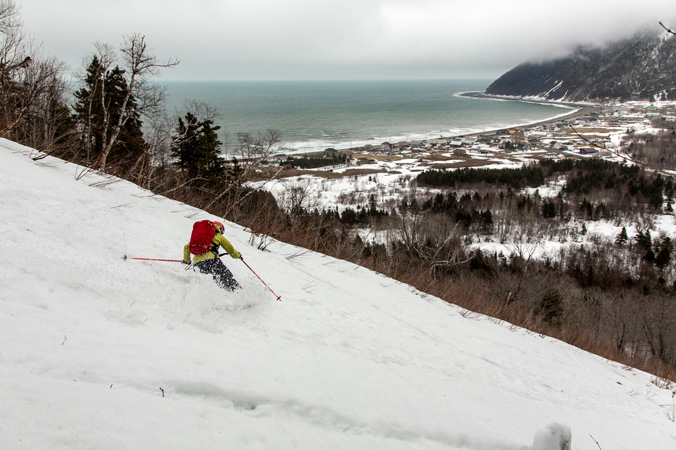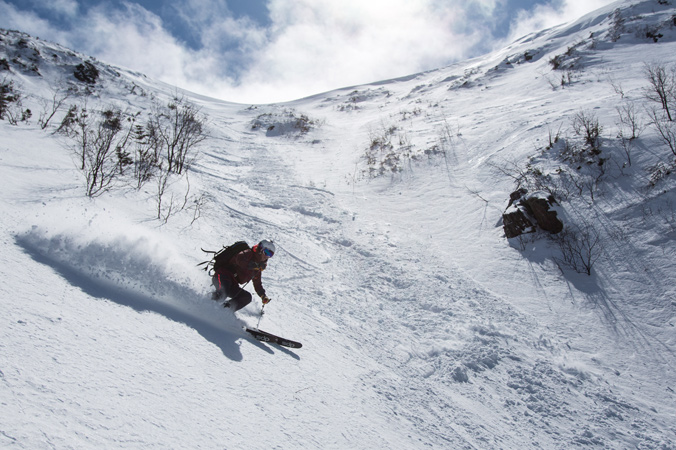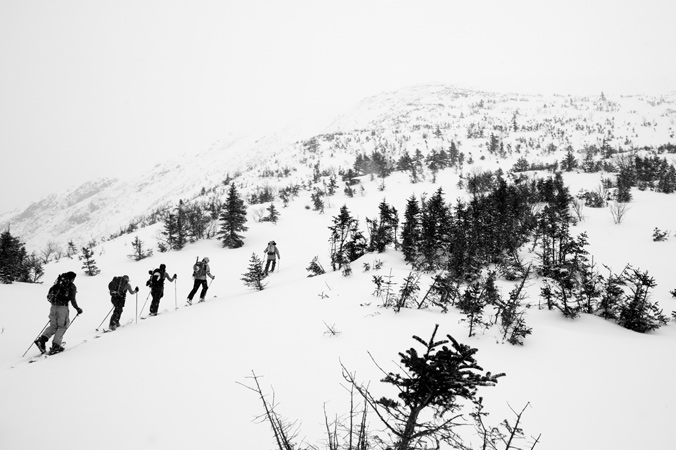
A rare East Coast ski-to-sea moment for the author. [Photo] Dana Allen
Two crullers and a large coffee from Tim Horton’s isn’t the best fuel for a day spent climbing couloirs, and my growling stomach echoes that notion as I dangle from a temporary ice-axe anchor. My friend Alix and I stand in the shadow of a 20-vertical-foot wall, three quarters of the way up the 600-foot Legends Couloir in the Madeleine Mines region of Québec’s Chic-Choc Mountains. We’re waiting for our guide, Charles Stevens, to make the call if we’ll ascend farther up the chute that’s topped with a sizeable and stubborn cornice.
I’am a little nervous hanging from the 40-degree slope, which continues to sluff to our left as we slowly work through layers of windslab. It’s a common hazard in this region of the flat-topped Chic-Chocs, which sits about 20 miles inland from the shores of the St. Lawrence River, where wind speeds have clocked 112 miles per hour.
Alix, unfazed, starts digging into her pack. “Do you want a Shot Blok?” she asks, holding out a handful of green semi-frozen cubes. I decline, thinking that I’d rather wait for the crab dinner we’re planning to acquire from Sainte-Anne-des-Monts fishermen who brave the icy seaway for a few weeks every April to haul in thousands of pounds of money-making sea creatures.
For most of Sainte-Anne-des-Monts’ existence, fishing has been the lifeblood of its 7,000 residents. Six hours north of Québec City and nestled between windswept capes at the tip of the Gaspé Peninsula, Sainte-Anne-des-Monts provides safe harbor for fishermen who spend their days battling the frigid, brackish waters of the 340-mile-long St. Lawrence Estuary, running from Québec’s Île d’Orléans to where it ultimately disperses into the Gulf of St. Lawrence. Their spring hauls typically include shrimp and queen crab—also known as snow crab, the smaller, eastern cousin to Alaska’s behemoth crustaceans—which we’re planning to enjoy tonight.
It’s easy to forget that, just an hour north of my Waterbury, Vt. home, a vast French-speaking province exists with a distinct old-world feel. Here, the Chic-Choc Mountains boast above-tree-line skiing not otherwise readily found in the Northeast. The main skiing attraction, Parc national de la Gaspésie, encompasses 25 peaks taller than 3,000 feet in its 802 square kilometers (roughly 500 square miles).

Alix Klein hunts for powder in the Madeline Mines’ “S Couloir.” [Photo] Dana Allen
During a Chic-Chocs trip early last year, I learned about the period in the spring that skiers refer to as “Corn and Crabs,” when, for a few weeks in mid-to-late April, the snow-crab fishing season coincides with corn in the mountains. And after that earlier trip, I’d been eyeing some bigger couloirs just outside the park and knew springtime would offer a chance to find them in skiable condition—and to partake in some traditional Québécois cuisine.
To help with travel arrangements, I’d looked to Canadian-certified guide Stéphane Gagnon, owner of Ski Chic-Chocs, which is based out of the Parc national de la Gaspésie visitor center, 24 miles from Sainte-Anne-des-Monts.
“Crab season is festive in the Chic-Chocs, because it’s when the coast and the mountains join together,” Gagnon explains. “The fishermen create a buzz on the coast with boats on the water, town is awakening from the winter deep freeze, the locals are energetic, and the skiing is usually at its max snow coverage with relatively good stability.”

In the Gaspésie, crab fishermen cast lines of a different kind. [Photo] Dana Allen
Alluring as it all sounded, skiing corn amid feasts of fresh crab hinges on one fickle thing—East Coast weather, which is notoriously temperamental in the Gaspésie where “lake effect” storms draw moisture from the St. Lawrence and can dump feet of snow inland but sometimes instead bring rain. So in spite of a potentially volatile forecast, I made the 10-hour drive north to learn more about the area’s economy as it evolves from fishing-based industry to one embracing growing recreational opportunities. And Gagnon is the ideal person to guide not only in the mountains, but also in town.
In 2001, he chose a rural lifestyle, moving from Montreal to the Gaspé Peninsula to work for Avalanche Québec, the region’s avy forecasting and observation organization. Then, in 2006, he started Ski Chic-Chocs—the primary guiding outfit within the park. But the initial draw to Sainte-Anne-des-Monts was not just mountain life.
“The first time I came here was in the mid ’80s; I was surfing along the coast,” Gagnon says. “This is a great place to sail, and when I moved here, I sailed to the Magdalene Islands (215 kilometers from the Gaspé Peninsula).” His relationship with water isn’t just for sport, however: Gagnon previously worked as a diver doing underwater work on the cement piers in Tourelle, a nearby crab-fishing port. “It was something I did to pay the bills in the summertime,” he says.
Others have also found this evolving community a promising place to start a business that caters to both residents and tourists. After noticing a lack of well-made, locally-sourced food, former Ski Chic-Chocs guide Marie-Eve St-Laurent opened Marie 4 Poches, a bakery and coffee shop in the heart of town. Despite the wealth of natural resources here from both land and sea, much of this area’s produce gets shipped farther afield. In the case of our trip’s crustacean of choice, shipments go to Québec City, Montreal and even as far as Japan, the primary importer of Québécois snow crab.

The fishermen of Tourelle bring in their haul. [Photo] Dana Allen
“When I arrived 15 years ago, the food here wasn’t very good—we had very few healthy food options around the peninsula,” St-Laurent says. “In the last few years, people here have realized that we are able to have good food even if we aren’t in the middle of Montreal or Québec City. Historically we’ve relied on fishing and mining, but now visitors are a huge part of the economy, and food is becoming a big part of tourism. It’s healthy to go out and ski, and that’s how we want our cities: healthy.”
I think about St-Laurent’s words and regret that her shop was closed the morning of our couloir mission—Tim Horton’s pastries don’t hold a candle to hers. But when Gagnon helps us put together a traditional Gaspésie snow-crab dinner after we’ve retreated from the Legends Couloir due to the unmovable, looming five-foot cornice formed by those high-speed St. Lawrence winds, my regrets about breakfast fade.
He explains that we’re lucky to have arrived when we did despite variable conditions, as the crab season ran shorter than usual this year. “The quotas go up and down, and this year most of them [crabbers] met their quotas early in April,” Gagnon says. “Crabbers are the fortunate ones—permits can cost millions of dollars, but even so, they’re all taken. They’re just sold from one fisherman to another, so getting a crab permit is like winning the lottery.”
And while Gagnon notes that money is still made in the traditional fishing arts, the industry is in decline. The 1992 collapse of the Newfoundland Grand Bank Cod Fishery forced the Canadian government to put a moratorium on cod fishing, effectively laying off 40,000 workers in the Atlantic fishing industry. Since then, fisheries like those in Sainte-Anne-des-Monts have relied primarily on crustacean hauls—a 2016 report done by the University of Victoria notes that 65-percent of Atlantic Canadian fishery landings are now attributed to crustaceans. But the profitability of crabs and shrimp, the report adds, can’t replace the void left by cod, and the weakening of this traditional industry has made room for the burgeoning recreation-based economy.

The crab walk in the Madeleine Mines. [Photo] Dana Allen
I ask Gagnon if he ever considered crab fishing, but he shakes his head. “I used to go out with a few friends,” he says, “but skiing is easier.” So we choose to enjoy the fruit of someone else’s labor, cooking crab over an outdoor burner in Gagnon’s yard, which lies 10 feet from the water’s edge where chunks of ice collect like layers in sedimentary rock.
Whether frozen or liquid, water serves as both inspiration and an economic driver for the community in the Gaspésie. “The water has always been part of the regional heritage here, and having the coast and the mountains, it gives you the possibility to do anything, to dream about adventure,” Gagnon says. And with people like him and St-Laurent capitalizing on this region’s abundant natural resources, the future of Sainte-Anne-des-Monts as a foodie destination with a skiing habit looks bright.










Related posts:
The Spearhead Doctorate: JD Hare traverses from the mountains to the blueberry patch and back
White Trash: An essay by Allan Bard & Tom Carter
Covering Ground: How to plan a dialed multiday traverse
Backstory: Turning Back